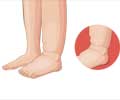Patients with severe arthritis can now benefit from total ankle replacement without permanent metal implants, say researchers.
Researchers say that patients having severe arthritis can now opt for total ankle replacement without having to put up with metal implants.
For years, patients have had the option of total joint replacement in the hips, knees, and ankle with titanium and other metal devices, but now researchers from UC San Diego Medical Centre have come up with a total ankle replacement technique that would offer increased mobility and pain relief."Up until now, patients have had two options for replacing their ankle joints: metal implants or fusion of the joints," said Daniel K. Lee, director of foot and ankle surgery at UCSD Medical Centre.
"Now there is an option that actually restores the ankle with an FDA-approved biologic material that is similar to the collagen found in cartilage," he added.
During the surgery, Lee removed the damaged cartilage around the ankle joint through a four-centimetre opening. The collagen material was then moulded into the joint where it adapts to the contour of the patient's ankle.
"Unlike a metal device, the advantage to this material is that the implant can be customized in size and contour for every patient's individual need. No matter how the patient's ankle is shaped, the collagen is a perfect fit," he added.
Later in order to allow the material to integrate fully with the ankle joint, a temporary external device was used to stabilize the joint area while keeping it "distracted" or open for a period of 4-6 weeks.
Advertisement
The device is then removed entirely, which keeps the patient's ankle free from any metal parts.
Advertisement
"The idea here is to avoid fusion of the ankle and to add longevity to the joint. We want to give patients as much mobility as possible so they can get back to the activities they love the most," he added.
The results of a study will be described in late 2008 in the Journal of Foot and Ankle Surgery.
Source-ANI
RAS/S










